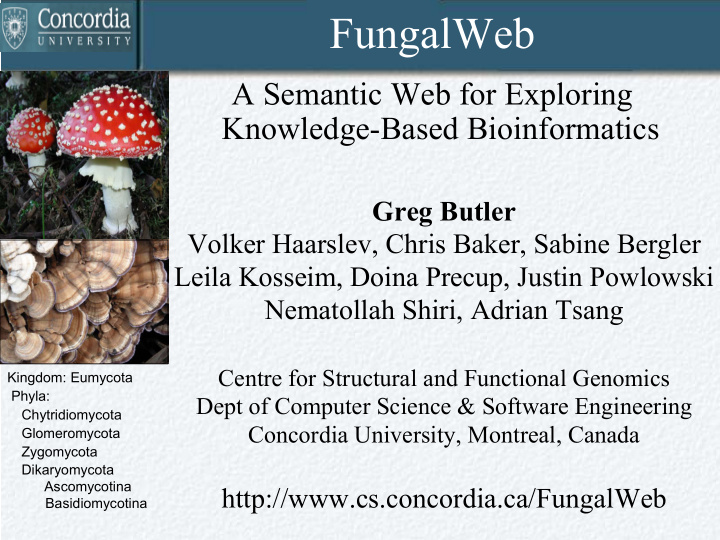



FungalWeb A Semantic Web for Exploring Knowledge-Based Bioinformatics Greg Butler Volker Haarslev, Chris Baker, Sabine Bergler Leila Kosseim, Doina Precup, Justin Powlowski Nematollah Shiri, Adrian Tsang Centre for Structural and Functional Genomics Kingdom: Eumycota Phyla: Dept of Computer Science & Software Engineering Chytridiomycota Concordia University, Montreal, Canada Glomeromycota Zygomycota Dikaryomycota Ascomycotina http://www.cs.concordia.ca/FungalWeb Basidiomycotina
Outline • Introduction to Knowledge-Based Bioinformatics • Introduction to FungalWeb •Fungi, Enzymes, Industry •FungalWeb Ontology •Application Scenarios •Conclusion
Introduction to KBB Knowledge-Based Bioinformatics Aim: Provide an automated Research Assistant to a bio-scientist [ie Make a human Research Assistant’s life more interesting] Find the data that … answers a question… Compute a … phylogenetic tree … of … Find all papers relevant to … What is the answer to …? How confident are you in the answer? On what evidence is the answer based? How did you arrive at the answer? What hypothesis best matches the evidence? What experiment should I perform to answer this question?
Introduction to KBB We all know how to create knowledge … Information retrieval , data collection, …. Information extraction , data access and analysis, … Organize … integrate data and knowledge from multiple sources classify examples into categories note relationships between examples and categories note patterns, rules, constraints, … Observe … correlations, trends, exceptions, … But how to (semi-)automate?
Introduction to KBB Transparent Access to Knowledge Tip of IceBerg Hidden Workflow Coordination Knowledge Representation Hidden Reasoning Storage, Access, Analysis Hidden Scientific Data Algorithms Hidden Literature Collections Typical Workbench for Knowledge-Based Bioinformatics
Introduction to KBB The vision is to turn data into knowledge … how best can the computer assist human knowledge workers Hypothesis : Use ontologies and the semantic web Web provides access, autonomy, diversity, … Ontologies organize knowledge: instances, concepts, relations, rules Ontologies integrate knowledge … bridge sites across web Software agents carry out plans, tasks, workflow, …reasoning,… But … is this enough, is it buildable , is it usable by bio-scientists
FungalWeb Semantic Web FungalWeb The External World Scientific Match Racer BioKEA Mutation Literature Maker Server Miner Form Computational Query Servers nRQL Query Service OntoIQ Ontology Domain Ontology Query Databases TBox Store OntoNLP Query RBox Store VizGraph Query Data ABox Store Warehouse Racer Storage mySQL
FungalWeb: Fungi, Enzymes, Industry The Kingdom of Fungi includes over 1.5 million species Pulp and paper Baking Brewing pharmaceutical Five kingdoms of life Personal care * Bruce Birren, Gerry Fink, and Eric Lander, The Fungal Research Community, Center for Genome Research, February 8, 2002
The FungalWeb Ontology ISWC05 2 nd prize (Semantic Web Challenge)
Application scenarios Scenario 1: Enzymes acting on substrates Scenario 2: Enzyme taxonomic provenance Scenario 3: Enzyme benchmark testing Scenario 4: Enzyme improvement
Enzyme Substrate Could an enzyme be used to degrade this novel chemical substrate ? Chemical Analysis describes it as a a polymer of: IUBMB Enzyme Nomenclature EC 3.2.1.67 Common name: galacturan 1,4-a- galacturon idase Reaction: (1,4-a-D- galacturon ide) n + H2O = (1,4-a-D- galacturon ide) n- 1 + D- galacturon ate Other name(s): exopoly galacturon ase; poly( galacturon ate) hydrolase; exo-D- galacturon ase; exo-D- galacturon anase; exopoly-D- galacturon ase Systematic name: poly(1,4-a-D- galacturon ide) galacturon ohydrolase NLP Semantic word stem summary: ‘ GALACTURON’
Enzyme Substrate Conceptualization desc desc Conceptual frame supporting the identification of pectinase enzymes using substrate word stems.
Enzyme Substrate Queries 1-Is Galacturon an instance for Semantic_word_stem_of_the_substrate_of_the_enzyme_reaction? Retrieve ( ) (||http://a.com/ontology#Galacturon| |http://a.com/ontology#Semantic_word_stem_of_the_substrate_of_the_enzyme_reaction|))) True 2-Find all Enzyme names which contain semantic word stem of the substrate of the enzyme reaction that matches with Galacturon Retrieve (?x) (AND (?x |http://a.com/ontology#Enzyme|)(?x |http://a.com/ontology#Galacturon| | http://a.com/ontology#Enzyme_description_contains_the_stem|) )) <<<?X :http://a.com/ontology#exopolygalacturonase:>> <<?X :http://a.com/ontology#pectin_lyase:>> <<?X: http://a.com/ontology#Pectin_methyl_esterase:>> <<?X:http://a.com/ontology#Exo_polygalacturonate_lyase:>> <<?X :http://a.com/ontology#Endopectinase:>> <<?X :http://a.com/ontology#pectate_lyase:>> <<?X :http://a.com/ontology#Pectin_acetylesterase:>>>
Pectinases
Enzyme Improvement: MutationMiner Mutation Miner (Baker and Witte 2004, Witte and Baker 2005)
Mutation Miner Designed to: • Extract from full-text papers, • …sentences that describe impacts of mutations, and • …legitimately map them to protein structures
Conclusions Data and knowledge integration works: •Fungal Web Ontology can support real biological questions not easily queryable from bioinformatics databases • Ontologies are difficult to build, evaluate, … • RACER nRQL syntax is expressive enough, but is unreadable to scientists Powerful approach to integrate ontologies, NLP, computation, and visualization eg Mutation Miner
Ongoing Work Better user interfaces to access data •OntoIQ form-based pattern-based interface for nRQL •OntoNLP natural language interface for nRQL •Visual graph-based queries FungalWeb data warehouse •A web of data for experimentation with DB, agents, and FungalWeb Ontology •A benchmark for genomics databases Ongoing validation of •PRM tools and application scenarios •NLP tools: Mutation Miner, BioKea, BioRAT
People and Science Issues Technology will always need organization to create knowledge! – IT being web services, semantic web, data, … – Ontologies offer a way to organize – Ontologies evolve through community use, review, … – This takes people : expert knowledge workers Remember human interaction steps – Data entry, Manual curation – Review, feedback, corrections, evolution,…of data and knowledge Remember science evolves through theories, evidence, refutation – What assumptions/theories are your computations based upon? – How do differing assumptions affect results? – Does your system accommodate competing conflicting theories? – Can you undo/refute all results based on a discredited theory/assumption?
Acknowledgements Volker Haarslev, Chris Baker, and all the FungalWeb team: see http://www.cs.concordia.ca/FungalWeb Adrian Tsang, Reg Storms, Justin Powlwoski, and the bioinformatics team on the fungal genomics project My graduate students: Farzad Kohantorabi, Ju Wang, Yue Wang, Michel Nathan
Recommend
More recommend